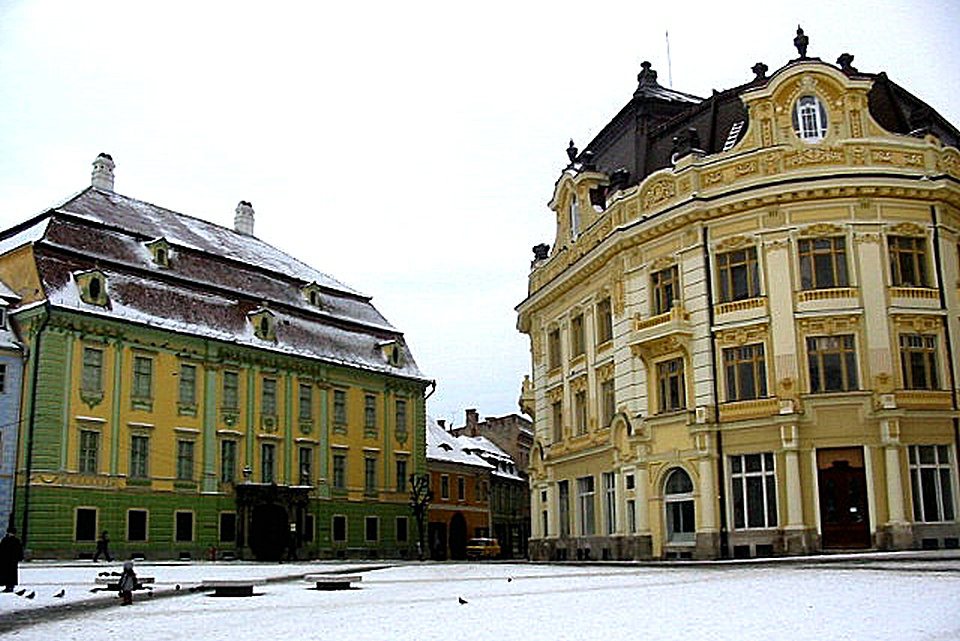The Brukenthal National Museum (Romanian: Muzeul Naţional Brukenthal; German: Brukenthalmuseum) is a museum, erected in the late 18th century in Sibiu, Transylvania, Romania, housed in the palace of Samuel von Brukenthal — who was Habsburg governor of Transylvania and who established its first collections around 1790. The collections were officially opened to the public in 1817, making it the oldest institution of its kind in Romania.
It is a complex of six museums, which, without being separate administrative entities, are situated in different locations around the city and have their own distinct cultural programmes.
The Art Galleries are located inside the Brukenthal Palace and include a number of about 1,200 works belonging to the main European schools of painting, from the 15th to the 18th century: Flemish-Dutch, German and Austrian, Italian, Spanish and French Schools. The Galleries also include collections of engravings, books, numismatics, and minerals.
The Brukenthal Library is also located inside the Brukenthal Palace. It comprises approximately 300,000 library units (manuscripts, incunables, rare foreign books, old Romanian-language books, contemporary books and specialised magazines).
A 2017 stamp dedicated to the 200th anniversary of the museum
The Museum of History is part of a building which is considered to be the most important ensemble of non-religious Gothic architecture in Transylvania. The museum initially focused its activities on representing the historic characteristics of Sibiu and its surroundings, but in time it has come to reflect the entire area of Southern Transylvania.
The Museum of Pharmacology is located in an historical building dated 1569, where one of the oldest pharmacies in present-day Romania was located. It is the basement of this house where Samuel Hahnemann invented homeopathy and developed his version of treatment. Some of his phials and plans are on display. The furniture is in Viennese style. The exhibition is organized on the structure of a classical pharmacy that includes two laboratories, a homeopathic sector and a documentation sector. It contains over 6,000 ancient medical instruments and dispensing tools from the time when Sibiu was home to more chemists than anywhere else in Transylvania. At the front, a reconstructed shop is decked out with wooden counters and stacks of glass jars creating the atmosphere of an 18th-century apothecary. A valuable collection of wooden pharmaceutical jars, marked with paint, is also featured.
The Museum of Natural History began to take shape in 1849, through the foundation of the Transylvanian Society of Natural Sciences (German: Siebenbürgischer Verein für Naturwissenschaften), which had as members important local and foreign figures in science and culture. The collections of the museum comprise over 1 million exhibits (including mineralogy-petrography, palaeontology, botany, entomology, malacology, the zoology of the vertebrates, amphibians, reptiles, as well as ichthyology, ornithology, and the zoology of mammals).
The Museum of Arms and Hunting Trophies reflects the evolution in time of weapons and hunting tools. Important is as well the collection of trophies belonging to the collections Witting and A. Spiess, the last one comprising 1,058 items acquired in 1963. Opened for the public in 1966 in Spiess House, the exhibition contains now over 1,500 units. Some traditional hunting procedures are also exhibited, including contemporary engravings. Aspects of the animal life and suitable times for hunting them are also presented here.
The Brukenthal Palace and the collections put together by Baron Samuel von Brukenthal represent the nucleus of the present Brukenthal National Museum. Since the baron and his wife had a daughter as the only child (who died at the early age of four) his testamentary dispositions stipulated that, on the death of the last heir in the male line of succession, the entire inheritance was to be placed in the custody of the Evangelical Church of Sibiu while the palace presenting his collections to be open for the public, event that happened in the year 1817. During the 19th century, the main concern of the Museum was to preserve the extant patrimony, to enlarge the main collections through the means of acquisitions and to establish new collections, especially in the range of the German-Saxon Culture. In the year 1948, the Museum was nationalized, becoming the property of the communist Romanian state. In 1948, the Transylvanian Society for the Natural Sciences in Sibiu ceased its activity, the museum under its patronage being included in the national patrimony. In 1957, the Museum of Natural Sciences became a part of the Brukenthal Museum. The “August von Spiess” Museum of Hunting has its opening in 1966. 1972 is the opening year to the Museum of Pharmacy. In 1988 was inaugurated the History Section of the Brukenthal National Museum, at present the Museum of History, in the Altemberger House. The Contemporary Art Gallery of the Brukenthal National Museum is the most recently acquired location (2006).
Samuel Brukenthal Biography:
Baron Samuel von Brukenthal (1721-1803) was the only representative of the Transylvanian Saxon community who acceded to high public office in the Austrian Empire under the Empress Maria Theresia (1717 – 1780), the first such office being that of Chancellor of Transylvania. The years spent in Vienna, in this capacity, were the years when the Baron started acquiring his collection of paintings, mentioned in Almanach de Vienne (1773) as being one of the most valuable private collections and generally admired by the cultivated Vienna public of the time. Baron’s initial collections (comprising the collection of paintings, a collection of prints, a library and a coin collection) were mostly put together in the period between 1759 and 1774. We have scant information as to how they came into being, the earliest records in the Brukenthal family being the archive concerning acquisition of paintings dating from 1770 (by which time the core of the collection of paintings must have been acquired). Appointed Governor of the Principality of Transylvania, a position that he occupied between 1777 and 1787, Samuel von Brukenthal built a Late Baroque palace in Sibiu, modelled on the palaces in the imperial capital.
